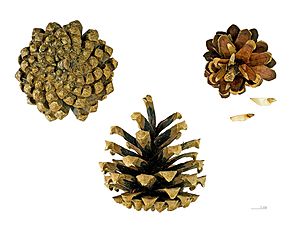Scots pine facts for kids
Quick facts for kids Scots pine |
|
|---|---|
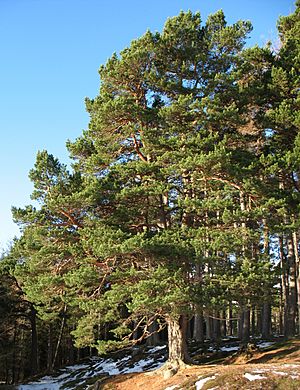 |
|
| Native Scots Pine at Glenmuick, Scotland. | |
| Conservation status | |
| Scientific classification | |
| Kingdom: | |
| Division: | |
| Class: | |
| Order: | |
| Family: | |
| Genus: | |
| Subgenus: |
Pinus
|
| Species: |
P. sylvestris
|
| Binomial name | |
| Pinus sylvestris |
|
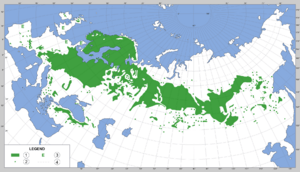 |
|
| Distribution | |
The Scots Pine (Pinus sylvestris) is a type of pine tree that grows naturally in Europe and Asia. You can find it from Scotland, Ireland, and Portugal in the west, all the way to eastern Siberia. It also grows south in the Caucasus Mountains and far north into the Arctic Circle in Scandinavia.
In the northern parts of its range, it grows from sea level up to 1,000 meters high. In the southern parts, it's a mountain tree, growing at higher altitudes from 1,200 to 2,600 meters. This tree has fairly short, blue-green leaves and bark that is orange-red.
Contents
What Does the Scots Pine Look Like?
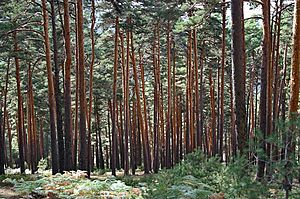
The Scots Pine is an evergreen coniferous tree. This means it keeps its needles all year round. It can grow very tall, up to 35 meters, and its trunk can be 1 meter wide. Some very old trees have been found to be even taller, over 45 meters! The tallest one recorded in Estonia was over 46 meters tall.
The bark on the lower part of the trunk is thick and dark grey-brown. Higher up on the trunk and branches, the bark is thin, flaky, and orange. Older trees often have a unique look with a long, straight trunk and a rounded or flat top of leaves. Scots Pines usually live for 150 to 300 years. The oldest known trees, found in Finnish Lapland, are over 760 years old!
Leaves and Cones
The young shoots of the tree are light brown with a spiral pattern. On mature trees, the leaves (which are also called 'needles') are a blue-green color. They often turn a darker green or yellow-green in winter. These needles are about 2.5 to 5 centimeters long and grow in pairs. Each pair has a grey base that stays on the tree. On strong young trees, the needles can be twice as long. Sometimes, they even grow in groups of three or four. Needles can stay on the tree for two to four years in warmer places, and up to nine years in very cold areas. Young seedlings have single, flat leaves that are about 2 to 3 centimeters long.
The seed cones start out red when they are pollinated. In their first year, they are small, round, and pale brown. In their second year, they grow to their full size, becoming pointed and oval-shaped. They turn from green to grey-green or yellow-brown when they are mature. These cones are about 3 to 7.5 centimeters long. The cone scales have a flat or pyramid shape with a small prickle in the middle. The seeds inside are blackish and about 3 to 5 millimeters long. They have a pale brown wing, which helps them fly away when the cones open in spring. This happens about 22 to 24 months after pollination. The pollen cones are yellow (sometimes pink) and about 8 to 12 millimeters long. They release their pollen in mid to late spring.
Where Do Scots Pines Grow?
Scots Pine is the only pine tree that grows naturally in northern Europe. It can form forests made only of Scots Pines, or it can grow mixed with other trees like Norway spruce, common juniper, silver birch, European rowan, and Eurasian aspen. In central and southern Europe, it grows with many other types of trees, including European black pine and mountain pine. In the eastern parts of its range, it grows with trees like Siberian pine.
How Are Scots Pines Used?
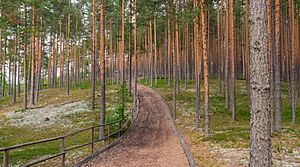
The Scots Pine is a very important tree in forestry. Its wood is used to make pulp for paper and also timber for building things. New trees can be grown by planting seeds, sowing them, or letting them grow naturally. For commercial use, trees are usually harvested after 50 to 120 years. In colder areas where trees grow slower, they might be left for longer.
In Scandinavian countries, people used Scots Pine to make tar a long time ago. While most of this industry has stopped, some tar producers still exist. The pine has also been a source of rosin and turpentine.
The wood of the Scots Pine is pale brown to red-brown. It is often used for general construction work. The wood is also used to make a special fabric called vegetable flannel. This fabric looks a bit like hemp but feels softer.
Scots Pine has also been planted in other parts of the world, like New Zealand and colder areas of North America. It was one of the first trees brought to North America, around the year 1600. In some places, like Ontario, Michigan, and Wisconsin, it is considered an invasive species. This means it can spread quickly and take over areas where native plants usually grow.
It was very popular in the United States for the Christmas tree trade from the 1950s to the 1980s. It's still used as a Christmas tree, but other types of fir trees are more popular now. Even though it can be invasive, Scots Pine sometimes doesn't grow very well in parts of eastern North America. This is because the climate and soil are different from its natural home. Also, pests and diseases can harm it. A tiny worm called the pine wood nematode can cause a disease that kills Scots Pines, often within a few weeks. This worm usually attacks trees that are at least ten years old.
Some special types of Scots Pine, called cultivars, are grown for their beauty in parks and large gardens. Some of these have even won awards for being great garden plants.
In the coal mining areas of Flanders, Belgium, Scots Pines were widely grown and used. Their wood was used to support tunnels in the mines. Miners liked them because the wood would make a cracking sound when it was about to break, giving them a warning to replace it. You can still see large areas of forest with mostly Scots Pines in the countryside there.
Images for kids
-
Roots of an old pine in Ystad, Sweden
See also
 In Spanish: Pino silvestre para niños
In Spanish: Pino silvestre para niños



